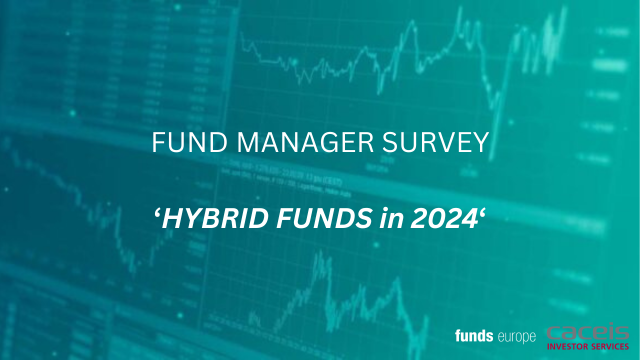Professionals in Luxembourg’s funds industry are preparing to attend the ALFI global asset management conference 2024.
Organised by the Association of the Luxembourg Fund Industry (ALFI), the March 19-20, 2024, conference at Luxembourg’s European Convention Center will draw fund professionals from Europe and beyond to exchange insights on market trends, regulatory shifts and business expansion. In this Funds Europe ‘Spotlight’ we speak with funds people about some of the conference issues, which include sub-advisory, investor protection, and AIFMD 2.
Julien De Mayer, CEO & founder, Fundcraft

Are regulators striking the right balance between encouraging investments in Europe on the one hand and protecting investors on the other hand?
In my opinion, European regulators currently lean towards over-regulation, emphasising investor protection but inadvertently hampering market innovation and competition (new product offerings, competition). This heavy regulatory environment, while safeguarding investors, and harnessing a trusted industry, places significant demands on industry participants.
Asset managers face the challenge of adhering to regulatory compliance, which consumes considerable resources and diverts their focus from their primary investment activities. This not only impacts their operational efficiency but also limits their ability to concentrate on their core mission of generating returns for investors.
The digitisation of fund administration emerges as both a crucial need and the solution. Consequently, regulations can be met without compromising the industry’s growth and dynamism, enabling asset managers to drive more investments and contribute to a thriving investment environment.
Julien Mechler, head of sub-advisory, BNP Paribas Asset Management

There is a growing prominence of sub-advisory funds. Why is this?
Sub-advisory is gaining more and more traction and its market share within the open architecture space is growing. Amongst several reasons, we can highlight two factors. The first one is ESG. Although this trend is self-explanatory and an important aspect of portfolio management, its implementation in open architecture is not easy. Mainly because every asset manager has its own ESG definition and criteria.
Sub-advisory provides a common framework to all delegated managers. During the selection process and life of the funds, we ensure consistent comparison and follow an approach to build a consistent range with common features. It’s the move from ESG taker to ESG maker.
The second one is active vs passive. One way to counterbalance the increase of passive management is to offer solutions for a network, answering its specific needs and requests.
Incorporating bespoke guidelines, financial or extra-financial, allows one to offer a tailor-made solution and be more attractive than ready-to-invest ETFs. Sub-advisory combines alpha capacities from asset managers and the specific framework of a network. Thanks to this positioning in between open-ended funds and dedicated ones, sub-advisory finds its place in the current investment landscape: win for the clients, win for the distributor and win for the asset managers.
Michael Derwael, senior director – independent risk, MFS & head of office for MFS Luxembourg

Distribution network management is evolving. For example, exemptions were allowed under AIFMD 2/Ucits VI. What further developments do you anticipate in the supervision of distribution networks?
The introduction of the initial Ucits and AIFMD regulations changed the distribution market irrevocably, ultimately leading to the convergence of due diligence practices, the introduction of automation and enhanced analysis into the process.
These existing trends will likely accelerate; asset managers will likely focus on distributors that allow them to reach goals and with which they can work within a risk-controlled framework. Businesses will also move towards platforms that fund providers can use to reach a multi-national client base, while increased industry collaboration, standardisation and mutualisation will likely lead to the development of ‘always on/ real-time’ due diligence and oversight.
Similarly, AI has the potential to continue to automate and integrate parts of the processes that could not be automated previously. AIFMD 2/Ucits VI may contribute to further streamlining approaches to make due diligence for some distributors simpler and perhaps better aligned with requirements applicable to institutional investors.
“aifmd 2/ucits vi may contribute to further streamlining approaches to make due diligence for some distributors simpler.”
Neil Wise, head of sales, Clearstream Fund Services

Distribution network management is evolving. For example, exemptions were allowed under AIFMD 2/ Ucits VI. What further developments do you anticipate in the supervision of distribution networks?
New technologies are set to streamline distribution networks while promoting wider adoption of KYC and AML standards, and enhancing distributor responsiveness.
Online due diligence platforms like ume are expected to become more sophisticated with the expansion of technological innovations. Initiatives like ALFI ManCo Marketing & Distribution Committee and the FINDEL Group will likely expand, offering industry-wide guidelines for best practices in areas such as ongoing monitoring and distributor KPIs. These initiatives are seen as efficient solutions to common issues, likely gaining broader acceptance nationally and internationally.
How are evolving ESG reporting requirements like potential SFDR amendments impacting Luxembourg investment funds and companies?
CSRD and SFDR drive sustainable finance and ESG transparency, challenging firms to comply with evolving regulations and diverse reporting needs. They mandate trustworthy ESG data disclosure along the value chain. Investment entities and firms must align with EU Taxonomy and stakeholder preferences, managing trade-offs to transition to sustainability while remaining competitive. This demands a holistic approach involving stakeholders and external expertise to ensure compliance and best practices. Embracing transparency offers benefits like enhanced reputation, innovation, and resilience.
Maren Stadler-Tjan, investment funds partner, Clifford Chance Luxembourg

Regulators have to strike the right balance between encouraging investments in Europe and protecting investors. What does this landscape look like?
Alongside the stimulation of private investment in the EU economy, particularly towards the
green and digital transitions, EU regulators have a keen eye on investor protection. Consistent themes are increased transparency, granularity and standardisation of investor disclosures, together with risk and liquidity management.
The EU has a broad range of regulatory regimes that sit in this space, including MiFID, the PRIIPs Regulation, the Ucits directive, AIFMD, Solvency II, IDD, the Eltif and the Sustainable Finance Disclosure Regulation. Add to this Member States’ domestic investment fund regimes and the varied needs of different segments of the investor market, and the regulators in the EU have a fine balance to strike in order to deliver, evolve, supervise and enforce investment fund regimes that are efficient, consistent and proportionate. The regulator’s job, therefore, is woven through a range of activities, including supervision, enforcement, guidance and stakeholder engagement.
“THE REGULATOR’S JOB IS WOVEN THROUGH A RANGE OF ACTIVITIES, INCLUDING SUPERVISION, ENFORCEMENT, GUIDANCE AND STAKEHOLDER ENGAGEMENT.”
Philippe Bourgues, country managing director, Caceis Bank, Luxembourg Branch

Are regulators striking the right balance between encouraging investments in Europe and protecting investors?
We believe regulators are striking the right balance by defining acceptable investment risk exposures for both retail and professional investors, then demanding strict enforcement of fund prospectus limits via depositary control and reporting disclosures. Nevertheless, professional investors do have access to higher risk investments as they have appropriate internal risk management frameworks. Strong protections, however, effectively lock retail
investors out of higher yield sectors like PERE, but asset tokenisation could soon see them gain access to these non-market-linked sectors, and boosting capital inflows to the European fund industry.
How are evolving ESG reporting requirements like potential SFDR amendments impacting Luxembourg investment funds and companies?
We are strong supporters of CSR and ESG principals but understand that they represent a significant administrative burden and reputation risk for clients. Sourcing reliable data, and then generating and filing reports is a complex, investment-heavy duty for investment managers and many have now turned to outsourcing to ensure hassle-free compliance.
Outsourcing involves pulling together a combination of specialist ESG data-provider flows, integrated with custodians’ reporting expertise, and innovative fintech partner apps, to take over the burden, ensuring full compliance with ESG commitments, and mitigating the associated reputation risk.
“STRONG PROTECTIONS, EFFECTIVELY LOCK RETAIL INVESTORS OUT OF HIGHER YIELD SECTORS.”
Olivia Moessner, partner, Elvinger Hoss Prussen

Could you please elaborate on the key regulatory and legal developments expected to shape the landscape in 2024, encompassing both EU-wide initiatives and those specific to Luxembourg?
There are several regulatory developments underway that will keep the industry busy in the coming years – ESG, the digital package, AIFMD II, Ucits VI, Eltifs and RIS – but one more particularly retains my attention as a Ucits expert. Esma and the European Commission are considering reopening the Ucits eligible assets rules. This should be monitored closely by the asset management industry. Narrowing the scope of Ucits eligible assets and economic exposures would be a step backwards for the Ucits products and put Ucits at a competitive disadvantage compared to other financial products. Narrowing the scope of Ucits eligible assets would decrease the latitude of active managers, mechanically increase systemic risks and reduce the financial offer and return that retail investors can expect.
Conversely, increasing the types of exposures Ucits could take would open up more possibilities for the Ucits world and allow for diversification of the offer. In that context, to the extent risks are adequately mitigated, further thought should be given to extending the allowed exposures and investment possibilities for Ucits, to boost their success and attractiveness. This would, in line with what has been done for Eltifs, give access to retail investors to alternative asset classes with higher liquidity standards in the Ucits environment.
Thomas Van Cauwelaert, head of France, Belgium and Luxembourg, Clearwater Analytics

In your opinion, are regulators striking the right balance between encouraging investments in Europe on the one hand and protecting investors on the other hand?
Regulators face a delicate task in balancing encouragement for European investments and safeguarding investors. Striking this equilibrium involves the constant refinement of regulations to foster a strong investment climate while implementing protective measures.
Whilst constant change can prove challenging, especially for regulatory reporting, the benefit of building confidence between investors and fund managers is critical. Compliance often includes provisions that protect investors’ interests, such as transparency requirements, accurate reporting, and safeguards against conflicts of interest. With that in mind, funds that can demonstrate integrity to foster trust will benefit in the long run.
How are evolving ESG reporting requirements, including CSRD and potential SFDR amendments, impacting Luxembourg investment funds and companies? What strategic approaches are businesses taking to comply, and what are their main implementation challenges?
Evolving ESG reporting requirements, particularly CSRD and potential SFDR amendments, impact investment funds as well as other financial institutions operating across Europe. Asset managers need to respond strategically by enhancing compliance measures and navigating challenges in implementation.
Recognising compliance’s role in fostering trust, investors appreciate protective provisions like transparency and accurate reporting. Instead of advocating for lighter regulations, a pragmatic approach involves assessing how adherence can enhance fund performance and showcasing professionalism to build investor trust. Ultimately, investors are generally more inclined to invest in funds that are fully compliant with applicable ESG regulations.
Mathieu Maurier, head of Societe Generale Securities Services Luxembourg

How are evolving ESG reporting requirements, including CSRD and potential SFDR amendments, impacting Luxembourg investment funds and companies? What strategic approaches are businesses taking to comply, and what are their main implementation challenges?
ESG reporting is still in its early stages even though some reporting already exists i.e. NFRD, TCFD reports, etc. The complexity is due to several factors. The most important one of all is the lack of harmonised and qualitative data sets and methodologies.
The different international standards requiring distinctive data sets are also a challenge. The ISSB vs CSRD approach is an interesting topic to follow as even though the two initiatives aim for more transparency, the approach and degree of transparency differ.
This is amplified when it comes to non-listed companies where the data is not available and needs to be collected directly. The gradual entry of CSRD will be a first step in the right direction.
The main implementation challenge for any ESG report remains the data and this is particularly the case with CSRD that requires more than 12.000 data points to be collected and reported with accuracy. Some solutions we build to assist our non-listed markets clients facilitate the data collection, but it still requires a big effort of the investee companies themselves to deliver in time.





